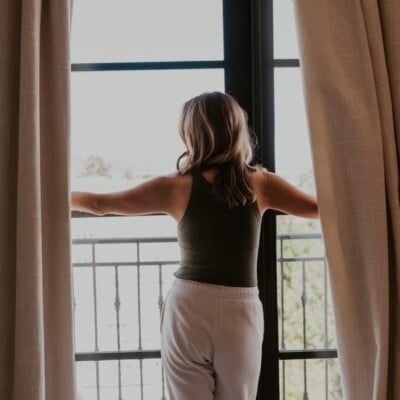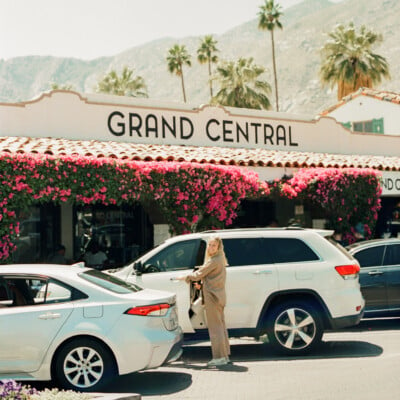The last time I was in Paris was by far the most magical. It wasn’t the weather, or the fact that it was the week before my wedding… I think the best thing about our visit was the time we spent on Canal Saint Martin. The canal is by far my favorite place to pass the time in Paris, so when Jessie Kanelos Weiner and Sarah Moroz offered up a guide to the neighborhood in their new book, Paris In Stride, I instantly yearned to be there again.
What makes Kanelos Weiner and Moroz’s walking guide to Paris even better? It’s filled with 150 breathtaking watercolor illustrations that make for a Francophile’s fodder on their own. The book is filled with comprehensive guides to all the cant-miss Paris spots, but today we’re focusing on my very favorite area: Canal Saint Martin.

A Walking Guide to Canal Saint Martin, from the pages of Paris in Stride
What was once a working class and somewhat shady neighborhood has been wholly transformed in the last decade. It’s now an aggregation of booming young businesses, and a prime picnic and drinking spot. Flanking the edge of the canal is an unmissable Parisian experience in good weather: here the public convenes in a communal urban rite, convivial and tipsily sun-kissed. The diagonal cut of the Canal St.-Martin links to the Canal de l’Ourcq by the Bassin de la Villette (the largest artificial lake in Paris), and is punctuated by arched bridges with placid views. The waterway is hugged by groups of friends, lone travelers, the occasional fisherman, and, further up, engaged games of pétanque. Boats pass leisurely through the waters; ducks (and littered beer cans) bob about. Snaking towards Pantin, the suburb just outside of Paris, this quarter is experiencing a slow gentrification (or “embourgeoisement”).
There’s still a clear divide in population and lifestyle once one crosses from the 10th to the 19th arrondissement at Métro Jaurès. It is worth exploring both ends of the canal to see the city’s evolution in plain sight, with some especially surprising architectural choices for subsidized housing to the north. The shifting population is not the only change to the area. The terrorist attacks on November 13, 2015 hit several cafés in the 10th arrondissement—a devastation to the city—but the spirit of the area has been unwavering in the aftermath. This thriving quarter has shown no scarring, only resilience and vitality.
1. Place de la République
The Place is a central meeting point between the 3rd, 10th, and 11th arrondissements. In 1867, sculptor Gabriel Davioud designed its central fountain, decorated with lions. A bronze Marianne, the personification of the French Republic, is surrounded by three statues personifying the national motto, liberté, égalité, fraternité.
2. La Trésorerie
Showcasing tasteful housewares, this loft-like and luminous boutique has a policy of working with artisans who track their line of production very closely; sustainability and artisanal savoir-faire are privileged. The wares span enameled-steel casseroles in pastel hues, prettily patterned notebooks from Lisbon stationers, Danish-designed table linens, Savon de Marseille hand soaps by Marius Fabre, and glazed earthenware espresso cups. The venue also has a small eatery, Café Smörgås, which serves Scandinavian-style breakfast and lunch, as well as pâtisseries and coffee.

3. Du Pains Et Des Idées
Foreigners tend to think all French bakeries are good, but there is a hierarchy — and this spot is at the tip-top. You can smell the boulangerie before you see it: an intoxicating buttery scent lures gourmands like an olfactory siren song.
4. Artazart
This art and design bookstore, with its bright red facade and regularly changing vitrines full of projects from ceramicists and illustrators, both reflects and draws in the creatives that hum around the canal. At the entrance is a glass case filled with Polaroid cameras; a room to the right showcases independent fashion magazines and cookbooks. Near the cash register are notebooks and paper goods; pick up a card to send home from the local Letterpress de Paris.

5. Le Vere Volé
With its purple exterior and frosted windows, this cave à manger helmed by Cyril Bordarier is also a to-go bottle shop. It started as a tiny venue with a toaster in 2000; after a significant remodel in 2010, it has expanded the kitchen and dining area, yielding sophisticated results. The market menu rotates daily, while also offering staple French classics (like boudin noir with mashed potatoes).
6. Le Comptoir Générale
Behind a green gate, follow the leaf-lined path to the neon pink arrow, then push back velvet curtains into this colonial-inflected cabinet of curiosities. The two vast rooms—linked by a chandelier-overhung hallway—have glass-capped ceilings, checkered doors, raw wooden beams, and shabby-chic mismatched couches; plants and vines dangle from everywhere. Over the weekend, the queues are long; pop by during the week or during the day to avoid the crowds.

7. Ten Belles
Just steps from the Canal Saint-Martin, order an espresso or filter coffee with baked goods prepared in-house in the café’s sprawling sister facilities in the 11th arrondissement: scones, sausage rolls, sweet buns, banana bread, brownies, and sandwiches.
8. El Nopal
Everything is made to order at this micro taqueria (purple-painted and barely wider than a doorway). The sign features a cactus— nopal in Spanish—and this ingredient is included in the tacos, tortas, burróns, and quesadillas on offer. There are no seats, so plan to eat alongside the canal. Not only is it copious, super-fresh, and accessible, it’s an easy antidote to the formality of sitting in restaurants and dealing with languorous French service.

9. Marin d’eau Douce
The Marin d’Eau Douce is a means of floating through the Bassin de la Villette, the Canal Saint-Martin, the Canal de l’Ourcq, and the Canal Saint-Denis. Available to rent by the hour or by the day, the self-driven, electrically-propelled boats made in the city of Nantes do not require a license and can accommodate groups of up to five, seven, or eleven people. The boats have a space at the front for picnicking and drinking.
10. Parc de la Villette
The Parc de la Ville e is the third-largest park in Paris, located at the northeastern edge of the city. Flat and spare, it was designed by Swiss-born architect Bernard Tschumi and built between 1984 and 1987 as part of an urban redevelopment project. Festivals are common in the park and an annual open-air film festival is a Parisian summer staple.
11. Philharmonie de Paris
Opened in January 2015, the Jean Nouvel–designed symphonic hall shimmers from a distance. The venue is the permanent residency of the Orchestre de Paris and regularly hosts renowned national and international orchestras. The rooftop is open to the public, providing an expansive view of the city as it melds into the suburbs.





